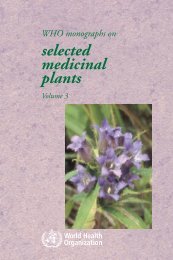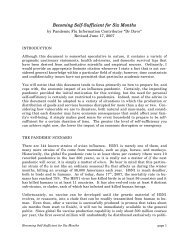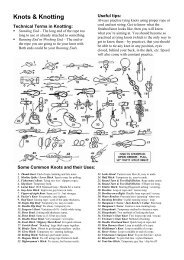Create successful ePaper yourself
Turn your PDF publications into a flip-book with our unique Google optimized e-Paper software.
WHITE SPORE PRINT<br />
The flesh of the cap is unusually brittle, never tough or stringy.<br />
There are many species; almost all are fairly large and share a common<br />
shape —squat, with a shallow, funnel-like cap and a thick,<br />
short stem. Their colors may run through the hues of the rainbow,<br />
and they vary in edibility from choice to undesirable. A few rare<br />
species are even suspected of being poisonous. Many have a sharp<br />
and bitter taste when fresh, but Giissow and Odell report that several<br />
species previously considered poisonous because of this taste<br />
are edible and delicious, since the objectionable flavor disappears<br />
when the mushrooms are cooked.<br />
<strong>Edible</strong>: LACTARIUS CILICIOIDES<br />
This species (Figure 22) illustrates the typical Lactarius shape.<br />
It is from 4 to 6 inches wide, about the same in height; the upper<br />
surface is white, or alternately banded in tan and white, and sticky;<br />
the inrolled margin or the entire surface is covered -with densely<br />
matted hairs.<br />
The juice is rather scanty, white but turning pale yellow almost<br />
as soon as it is exposed to the air (this is especially noticeable where<br />
gills and flesh join) and in a few minutes becoming white again.<br />
It is fairly common, especially in coniferous woods, in late summer<br />
and fall, individual specimens being scattered through the forest.<br />
Eminently edible: LACTARIUS DELICIOSUS<br />
This species (Figure 23) has the shape and size more or less<br />
characteristic of the genus, being about 4 to 5 inches both in width<br />
and in height. In color it is fairly amazing; the upper surface is<br />
pale orange, fading to tan with age, and is often zoned with broad<br />
concentric bands of pale orange and tan. The gills are reddish<br />
orange, becoming green with age or when bruised, and the yellow<br />
or orange juice is produced copiously, droplets of it standing out<br />
in sharp contrast to the greenish gills of old specimens. The short,<br />
thick stem is colored like the cap and becomes green where one<br />
49
















